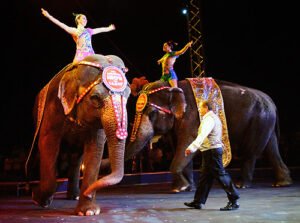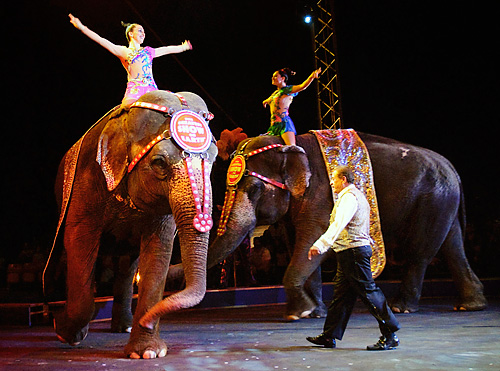Enter the intriguing realm of circus history and evolution over time. Since its modest beginnings, the circus has grown to become a worldwide phenomenon, captivating spectators with its magnificent show for centuries. The origins of the circus can be found in the prehistoric eras, when entertainers and acrobats mesmerized audiences with amazing feats. But the contemporary circus really began to take shape in the 18th and 19th centuries, when innovators like Philip Astley laid the groundwork for the spectacular productions we see today.
The circus evolved into a touring extravaganza that featured a captivating line-up of performances, such as fearless aerialists, magnificent animals, and hilarious clowns. The circus kept evolving over time, embracing new technologies and expanding the realm of entertainment. Take a trip with us through the fascinating history of the circus and see how it has changed so dramatically throughout the years, demonstrating the persistent charm that has mesmerized audiences for decades.

Quick Navigation
Circus History And Evolution Over Time
A Tour Through the Development of Circuses Throughout History
With its brilliant colors, captivating acts, and amazing feats, the fascinating world of the circus has a rich history spanning several centuries. This essay examines the fascinating development of circus history and evolution over time, highlighting the pivotal moments and influential personalities that have molded this unique kind of entertainment.
Origins and Historical Progenitors
The history of the circus and its evolution over time have their origins in prehistoric societies, where the idea of public entertainment was first introduced. With their opulent coliseums and amphitheaters, the Greeks and Romans laid the groundwork for early acts akin to circus acts. The coordinated spectacle of acrobats, jugglers, and horse shows captivated audiences during these events. A forerunner to the current circus, the idea of putting several performances together in one location started to take shape.
The creator of the modern circus, Philip Astley
The rise of English entrepreneur and equestrian Philip Astley in the 18th century marked a turning point in the history of the circus. Astley founded the first modern circus in London in 1768, with a ring that was designed to accommodate horse acts. This invention established the framework for the modern circus structure, whose central ring serves as the hub for an array of entertaining performances. The essential heart of this amazing show was shaped by Astley’s vision, which signaled a turning point in circus history and evolution over time.
Various Actors with the First Marvels
The 18th and 19th centuries saw the circus change and become a melting pot of many acts, which added to its attraction. While horse shows continued to be the major attraction, the repertoire was expanded to include tightrope walkers, acrobats, and jugglers. Elephants and camels among other exotic creatures added a touch of the wild to the circus ring, captivating spectators with their unusual and exotic features. With its comic flair, clown acts established a laugh-filled heritage that is still present in circuses today.
Read Also: List Of 10 High Paying Jobs without Degree or Experience
The Nomadic Circus: Itinerant Enchantments
The circus experienced a radical change in the 19th century, moving from being a fixed show to a traveling wonder that traveled across vast stretches of territory. Entertainers and circus operators saw the value of bringing the show outside of city limits and into local villages. This mobile strategy was made possible by the invention of the circus tent, a transportable and adaptable structure that let the spectacle of the circus take place outside. With this change, access became more democratic and the circus became a source of pleasure for people from all walks of life.
Technological Wonders and Sight-Givers Paragons
Over time, technology became a major factor in circus history and evolution, ushering in a new era of spectacle and invention. The invention of steam power transformed circus troupe transportation, allowing them to travel great distances more effectively. The invention of the electric light bulb revolutionized the circus experience by allowing shows to go into the night and enhancing their luminosity.
Technological developments in sound amplification enhanced aural perception, providing audiences with a multi-sensory experience. Circus shows are still shaped by technology in the digital age, with innovative effects, multi-media displays, and interactive components stretching the bounds of what is conceivable.
Changing Scenery and Modern Changes
The circus sector has seen important turning points and adjustments that are indicative of the changing social and cultural environment. Grander and more expansive performances became the norm when the Ringling Bros. and Barnum & Bailey Circus popularized the three-ring circus in the late 19th century. The inclusion of female performers questioned gender norms and brought fresh viewpoints and skill sets to the circus scene.
The 20th century saw a reevaluation of the usage of animals in circuses due to ethical concerns and shifting public perceptions, which resulted in modifications to laws and procedures. The rise of contemporary circus arts, which fuse classic aspects with contemporary design, is a reflection of the circus’s continuous development as it adjusts to changing circumstances.
Read Also: The University of Auckland – History, Admission, Total Review
Cultural Flexibility and Lasting Enchantment
Circuses are a timeless form of entertainment whose history and evolution over time demonstrate its cultural resilience and enduring enchantment. The circus has weathered shifting winds and left a lasting imprint on the fabric of culture, from its modest beginnings in antiquated arenas to the contemporary big tent. The circus has always been able to astonish and delight people, as seen by its adaptability, inventiveness, and capacity to enthrall audiences.
The Story That Never Stops
The story of circus history and evolution over time is a dynamic one of imagination, tenacity, and the unwavering spirit of showmanship. The circus has evolved and changed over time, becoming a staple of human amusement from prehistoric times to the present. In order to ensure that the enchantment of the circus continues to captivate audiences’ hearts and minds all over the world, we honor the performers, inventors, and visionaries who have contributed to the rich legacy of the circus as we celebrate its history and progress.
What role did the ancient civilizations have in the circus’s early history?
Ancient civilizations were crucial in establishing the foundation for this captivating show, according to the great narrative of circus history and evolution over time. The origins of the circus can be found in the amphitheaters and arenas of ancient Greece and Rome, which hosted shows with acrobats, horseback riders, and exotic animals.
With its enormous area and tiers of seating, the Colosseum served as a venue for these early circus-style events, enthralling spectators with daring performances and dramatic displays. These ancient cultures planted the idea of bringing together a variety of acts in one location, which laid the groundwork for the circus’s subsequent centuries of development.
Read Also: The Most Expensive Chair Ever Sold
Which notable individuals from the 18th and 19th centuries contributed significantly to the development of the modern circus?
The 18th and 19th centuries stand out as a time of revolutionary invention as we trace the development of circus history and evolution over time. One notable person is the English equestrian Philip Astley, who is frequently given credit for founding the first modern circus in 1768.
The modern circus format originated with Astley’s circular ring design, which allowed for horse-drawn performances. The development of the circus was further aided by pioneers like Charles Dibdin and John Bill Ricketts, who brought new aspects like music and clown acts. These trailblazers not only left a lasting impression on the history of the circus, but they also improved and codified its structure while providing audiences with entertainment.
Which performers and attractions made up the bulk of early circus performances?
Performances were a kaleidoscope of daring exploits and breathtaking acts in the early chapters of circus history and evolution over time. One of the main draws was the equestrian exhibits, where talented riders demonstrated their abilities on the circus arena. Acrobats, tightrope walkers, and jugglers all brought a mysterious and thrilling element to the show while enthralling spectators with their defying abilities.
Exotic creatures, such as lions and elephants, were recognizable elements and gave the circus show a hint of the wild. With their humorous antics, clown performances made people laugh and smile, resulting in a well-rounded entertainment experience that appealed to a wide range of viewers.

What effect did it have on the circus’s popularity and how did it become a traveling show?
A critical turning point in the circus’s history and evolution over time is when it became a touring show. During the 1800s, entrepreneurial circus performers realized the possibility of touring and presenting their act to a wider audience. This change made the circus more accessible to a wider audience and democratized access to it for those living outside the cities.
This itinerant strategy was made possible by the invention of the circus tent, a transportable and adaptable structure that let the spectacle of the circus unfold outside. The traveling circus expanded its appeal to a wider audience and solidified its reputation among a variety of groups by becoming associated with excitement and adventure.
What effects has technology had on the way the circus has changed throughout time?
Technology has been a major factor in the history and evolution of the circus, helping it to enter new and innovative domains of spectacle. The invention of steam power transformed circus troupe transportation, allowing them to travel great distances more effectively. The invention of the electric light bulb revolutionized the circus experience by allowing shows to go into the night and enhancing their luminosity.
Technological developments in sound amplification have additionally enhanced the audio aspect of the circus, augmenting the spectators’ total sensory encounter. With cutting-edge effects, multimedia displays, and interactive features that push the limits of what is possible in the circus arena, technology continues to play a part in circus productions in the digital age.
Recommended:
- University College Copenhagen – Total Review, History, Admission & Programs
- Meditation For Depression
- 15 Best Cafes In Newcastle
- Top 10 Free Boarding Schools For Troubled Teens and Youth
Could you list a few noteworthy turning points or adjustments that the circus industry underwent that signified its progress throughout time?
As we follow the development of circus history and evolution over time, a number of significant events and developments stand out as evidence of the circus’s ongoing vitality. Grander and larger-scale shows became the norm when the Ringling Bros. and Barnum & Bailey Circus introduced the three-ring circus in the late 1800s. The inclusion of female performers questioned gender norms and brought fresh viewpoints and skill sets to the circus scene.
Regulations and ethical issues changed in the 20th century as a result of a reevaluation of the usage of animals in circuses brought on by environmental concerns. The emergence of contemporary circus arts, which fuse traditional components with contemporary design, is indicative of the circus’s continuous development as it adjusts to shifting social and cultural contexts.
As a narrative intertwined with strands of ingenuity, inventiveness, and the unwavering spirit of showmanship, the fascinating story of circus history and evolution over time emerges. The circus has endured throughout time, captivating audiences all over the world and leaving an enduring impression on the cultural landscape from ancient arenas to the contemporary huge top.
SEE ALSO:
Trust you found our article on Circus History And Evolution Over Time helpful. Follow our website for more interesting articles.

